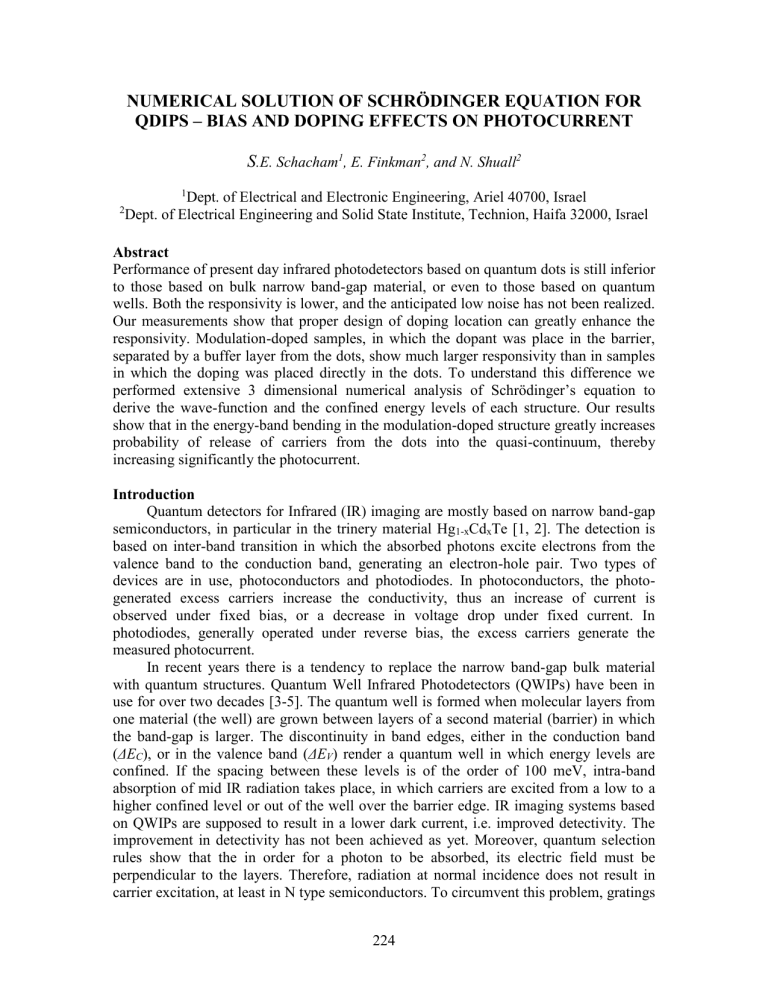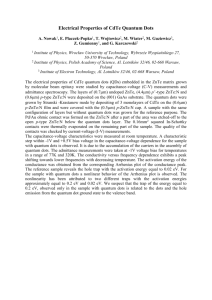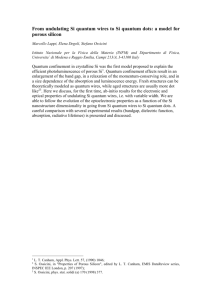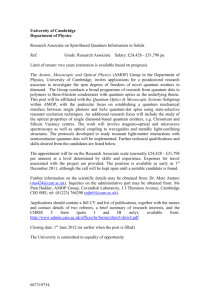NUMERICAL SOLUTION OF SCHRÖDINGER EQUATION FOR

NUMERICAL SOLUTION OF SCHRÖDINGER EQUATION FOR
QDIPS – BIAS AND DOPING EFFECTS ON PHOTOCURRENT
S .E. Schacham
1 , E. Finkman 2 , and N. Shua l l 2
1 Dept. of Electrical and Electronic Engineering, Ariel 40700, Israel
2 Dept. of Electrical Engineering and Solid State Institute, Technion, Haifa 32000, Israel
Abstract
Performance of present day infrared photodetectors based on quantum dots is still inferior to those based on bulk narrow band-gap material, or even to those based on quantum wells. Both the responsivity is lower, and the anticipated low noise has not been realized.
Our measurements show that proper design of doping location can greatly enhance the responsivity. Modulation-doped samples, in which the dopant was place in the barrier, separated by a buffer layer from the dots, show much larger responsivity than in samples in which the doping was placed directly in the dots. To understand this difference we performed extensive 3 dimensional numerical analysis of Schrödinger’s equation to derive the wave-function and the confined energy levels of each structure. Our results show that in the energy-band bending in the modulation-doped structure greatly increases probability of release of carriers from the dots into the quasi-continuum, thereby increasing significantly the photocurrent.
Introduction
Quantum detectors for Infrared (IR) imaging are mostly based on narrow band-gap semiconductors, in particular in the trinery material Hg
1-x
Cd x
Te [1, 2]. The detection is based on inter-band transition in which the absorbed photons excite electrons from the valence band to the conduction band, generating an electron-hole pair. Two types of devices are in use, photoconductors and photodiodes. In photoconductors, the photogenerated excess carriers increase the conductivity, thus an increase of current is observed under fixed bias, or a decrease in voltage drop under fixed current. In photodiodes, generally operated under reverse bias, the excess carriers generate the measured photocurrent.
In recent years there is a tendency to replace the narrow band-gap bulk material with quantum structures. Quantum Well Infrared Photodetectors (QWIPs) have been in use for over two decades [3-5]. The quantum well is formed when molecular layers from one material (the well) are grown between layers of a second material (barrier) in which the band-gap is larger. The discontinuity in band edges, either in the conduction band
(
ΔE
C
), or in the valence band (
ΔE
V
) render a quantum well in which energy levels are confined. If the spacing between these levels is of the order of 100 meV, intra-band absorption of mid IR radiation takes place, in which carriers are excited from a low to a higher confined level or out of the well over the barrier edge. IR imaging systems based on QWIPs are supposed to result in a lower dark current, i.e. improved detectivity. The improvement in detectivity has not been achieved as yet. Moreover, quantum selection rules show that the in order for a photon to be absorbed, its electric field must be perpendicular to the layers. Therefore, radiation at normal incidence does not result in carrier excitation, at least in N type semiconductors. To circumvent this problem, gratings
224
are formed on top of the detectors, a process which makes the device substantially more complicated and expensive. The major advantage of QWIPs is the relative ease of production of large scale matrices with very high uniformity. Indeed, several European companies market imaging systems based on QWIPs.
More sophisticated are infrared detectors based on quantum dots (QDIPs) [6-13].
Here the lower band-gap core material is surrounded in all three dimensions by the wider band-gap barrier material. Thus the confined energy levels within the dots are completely discreet. Unlike quantum wells, in which the one-dimensional confinement allows a continuum of the wave-vector within the plane of the well, here the levels form an almost delta function. In this structure the above mentioned selection rule is broken, and normal incidence radiation is absorbed, as, indeed was shown experimentally [10, 13]. Moreover, the discrete energy levels were expected to greatly reduce the capture rate of excited carriers [1]. The effect, known as “phonon bottleneck", has not been observed experimentally [15-20], except for some particular structures [21]. On the contrary, it has been shown that electron-phonon coupling, known as polarons, provide an alternative route for carrier recombination thereby eliminating the bottleneck [22-29].
One of the most convenient techniques of producing quantum dots is by the
Stranski-Krastanow growth mode [30-32]. The starting step is the growth of a layer, called “wetting”, of the material with the narrower energy band-gap, over the barrier material with the larger energy band-gap. Taking advantage of the mismatch between the lattice constants of the two materials and surface tensions, as the temperature is raised,
“droplets” are formed. Thus quantum dots are generated in a self-assembled fashion. In our research we use the combination of Si (with room temperature E
G
of 1.12 eV) and Ge
(with room temperature E
G
of 0.67 eV). The lattice mismatch is about 4% between the two materials, and Ge dots are formed over the wetting layer. The SiGe material system is very attractive since it has the potential of implementation within VLSI circuitry.
Indeed, in recent years QWIPs [33-35] and QDIPs [36-38] were implemented in this material system.
In order to investigate the option of implementing mid infrared detectors with the
SiGe material system, we produced two similar QDIP structures. The only difference between them was that the doping material was placed at different locations. There are major differences between the measured responsivity obtained from the two structures, throughout the photoconductive spectra. Moreover in both cases the character of the spectra changed drastically with bias. In order to get a deeper insight into these phenomena, we analyzed the quantum dots using a three dimensional numerical solution of the Schrödinger equation.
Experimental Devices
Two different structures of QDIPs based on Ge dots embedded in a Si matrix were investigated. In both cases the dots have the shape of a lens or a dome with a circular base. Typical height of the dots is around 5 nm and their base diameter is around 100 nm.
The inner part of the devices, containing the QDs, was sandwiched between two contact
Si layers, p-doped to 10
18
cm
-3
, followed by top and bottom Si buffers layers, unintentionally doped, 200 nm thick. The active part is composed of 15 periods of SiGe dots, self-assembled over Si layers, grown by the Stranski-Krastanow technique from the
225
Ge wetting layer. The barrier Si layers were thin, so even though the dots are randomly located, they are stacked one above the other. Figure 1 shows a cross-section transmission electronic microscopy image of such structure. The dots appear in dark contrast over the
Ge wetting layer.
Fig.
1 : Cross-section TEM image of structure showing stacking of dots (dark)
Due to Si diffusion into the dots, the obtained dots are not pure Ge. Rather, X-ray analysis shows a content of about 50% of Si in the dots [38]. At this content of Si the discontinuity in the conduction band is negligible since almost the entire band-gap difference between the gap of dot and that of the barrier shows up as a valence band discontinuity of about 300 meV, as shown in Fig. 2. Therefore confined levels are those of holes, within the valence band. Hence, detection of infrared radiation by inter-level transitions is based entirely on excitations of holes. In order for such a transition to result in photocurrent the hole must be excited from confined dot levels into the quasicontinuum.
The difference between the two structures under investigation is the location of the p-type doping. In the first structure, 410, the doping was introduced into a 5 nm thick layer, 2 nm below the Ge layer. In the second structure, 411, the doping was introduced directly in the Ge wetting layer, hence into the dots. In both cases the doping resulted in a sheet concentration of approximately 5x10
11 cm
-2
. Since the dot sheet concentration is in the range of 2-3x10
9 cm
-2
, the number of carriers per dots is about 200. The rest of the Si was not intentionally doped.
226
E
C
E
V
Band alignments
Fig.
2 : Band offset of Si
1-X
Ge
X
strained layers on Si substrates vs. Ge content (X)
Experimental Results
In order assure that the only significant difference between the two investigated structures was the location of the doping, low temperature photoluminescence (PL) measurements were performed. The spectrum for structure 411 resembles that of 410 but is weaker and noisier. Several peaks are present in the PL spectra in the range of 0.82-
1.12 eV. These peaks are associated with direct Si transition, Si excitons, those assisted by phonons, and transitions associated with the wetting layer. A Lorenzian decomposition of the two PL spectra into their constituent lines shows that the peak energies are almost identical. Hence the resemblance of the structures is almost complete.
Photocurrent was measured as function of wavelength (photon energy) in the range of 2.5-20 µm i.e. 60-500 meV. Both FTIR and grating spectrometers were used. The photoconductive waveforms recorded show several transitions. Figure 3 shows a set of spectra measured by FTIR at 13 K on structure 410. The radiation was introduced through the substrate, which was polished at 45° to allow both S and P orientations. This enables investigation of polarization effects on the spectra.
Both PL and photoconductive spectra measured on structure 410 where much larger and less noisy than those obtained on structure 411. Figure 4 shows spectrum measured on structure 411 with the grating spectrometer while Fig. 5 spectra obtained for structure under similar conditions (13 K, forward bias). Clearly, even though the first was taken at a larger bias (4 V as compared to 1 V for 410), the signal obtained from 411 is orders of magnitude weaker.
227
Fig. 3 : PC spectra of structure 410 for both polarizations at various bias voltages
P
C si g n al
Fig. 4: Grating spectrometer PC spectra for 411 at 4V
Fig. 5: Grating spectrometer PC spectra for 410 filter at 1V
228
Numerical Analysis
The experimental results show a definite advantage of the photoconductive response of the modulation doped structure (410) over that with doping in the dots (411). It should be pointed out that a carrier can contribute to a photocurrent only if the photo-excitation turns it “free”. Unlike absorption, in which the carrier can be excited to a higher confined level within the dot, here it must eventually leave the dot. This can be accomplished either by a one step excitation into the quasi-continuum, or a two step process, in which the carrier is first excited into a shallow confined level, and from there into the continuum, usually by tunneling. Even though the first is a direct process, the probability
(oscillator strength) of bound to bound transition is much larger. Therefore the two-step process is much more likely. Tunneling out of a shallow level is achieved since the applied bias tilts band edge and forms a rectangular barrier. Thus, the probability of tunneling out of a shallow level increases super-linearly with bias. In order to obtain a deeper insight to this phenomenon, and derive possible practical implications on performance of QDIPs, we performed numerical analysis for the two structures.
In order to obtain a qualitative understanding of the measured data, we performed
1-D and 3-D simulations of the quantum structures. The 1-D analysis was performed on a
SiGe quantum well, using the Nextnano software. As shown in Fig. 6, while the wavefunction is completely contained within the well in a structure in which the doping is placed in the well, simulating structure 411 (left side of the figure), it "spills" significantly out of it when the doping is located in the barrier there, simulating structure
410 (right side of the figure).
-0.05
-0.1
-0.15
-0.2
-0.25
-0.3
-0.35
-0.4
Ec1
Ec2
Ec3
Ev1
Ev2
Ev3
Fe
Fh
-0.08
-0.1
-0.12
-0.14
-0.16
-0.18
Ec1
Ec2
Ec3
Ev1
Ev2
Ev3
Fe
Fh
-0.45
-0.2
-0.5
-0.22
470 480 490 500 510 520 530 480 485 490 495 500 505 510 515 520
Fig. 5: Wave-function 1-D analysis simulating structure 411 (left) and 410 (right)
T he 3-D analysis was reduced to a two-variable problem by
assuming a cylindrical symmetry . The single band Schrödinger equation was solved numerically, using the effective mass approximation model, over a 2D grid for each quantum dot dimension:
229
2
2
z m h
1
z
2 m h
2
1
r
r
l r
2
2
h
E
, ,
In this equation, m h
is the effective mass of holes taken for bulk material. V r z h
( , ) is the effective potential for holes, which incorporates all the heterostructure effects such as band offsets, strain effects and electric field. The potential was derived using SimWin software. Because of the assumed cylindrical symmetry, the wave-function is expressed in cylindrical coordinates as: with l
0 for the S-like levels,
nl
e il
nl
(4)
1
2 l
for P-like levels, etc. Aside from the cylindrical symmetry, no other assumptions were made concerning the wave- function. This simplification of 3D simulations was shown in other cases to provide successful interpretation of experimental results (39).
GeSi
Si
Wetting layer
Fig. 6: Dot grating input for 3D simulations
The Hamiltonian in equation 3 is solved using a finite difference scheme in which
the wave-function is spanned by a discrete base along a rectangular grid, as shown in Fig.
6. The shape of the dot, taken as 25 nm in radius (average radius at half the dots height), is obtained by rotating this cross-section around the z-axis. The derivatives are evaluated numerically. Since a variable grid is used, the following formulas are used for the first i
, derivate with respect to the radius r:
r i
r i
1
i
r i
1 i
1
r i
1
r i
1
i
1
r i
i
i
1
r i
1 r ( r r i i
1
)
i
(
r i
1
r i
1
) i i
1
i
1
r i
r i
1
(
r i
1
) and for the second:
,,
2
i i
1 r ( r i r i
1
)
r
2
i
1 i r i
r i
1
(
2
r i
1 r i
1
)
230
where r i r i
1
r i
is the grid spacing. Similar formulas are used for the z-axis derivatives. For the end points parabolic interpolation is used. The grid points are located in the center of each volume elements they sample, so the problem of the origin is avoided.
Figure 7 shows the edge of the valance band and the confined energy levels ( n values) for structure 411 under negative bias, Fig. 8 shows the same for structure 410, and Fig. 9 for the same structure under positive bias. The various columns (colors) are increasing values of l starting with 0 (red, leftmost marks).
SiGe QD+WL h=20A r=25A doped inside , 1V R side
0.4
0.35
0.3
0.25
0.2
0.15
0.1
0.05
0
-80 -60 -40 -20 0 20 40 60 80
Fig. 7: Simulation results for band bending and confined energy levels for structure 411 under negative bias, for increasing l values.
0.4
0.35
0.3
0.25
0.2
0.15
0.1
0.05
0
-80 -60 -40 -20 0 20 40 60 80
Fig. 8: Same as Fig. 7 for structure 410. Doping is on the left.
231
0.4
0.35
0.3
0.25
0.2
0.15
0.1
0.05
0
-80 -60 -40 -20 0 20 40 60 80
Fig. 9: Same as Fig. 8 for positive bias
Structure 410 is greatly asymmetric. The valence band approaches the Fermi level at the doping site. This results in a significant reduction of both the effective tunneling width and the barrier height towards the doping. The barrier reduction is in the direction of positive bias. On the other hand, structure 411 is almost symmetric, except for the wetting layer location, therefore the zero bias bending is minimal. Since the tunneling probability is exponentially dependent on the tunneling width, we anticipate a much larger PC current in structure 410 than in structure 411, and in forward bias than in negative, as indeed were observed experimentally.
Fig. 10 a: Simulation results for wave-function of 411 under negative bias
232
Fig. 10 b: Simulation results for wave-function of 410 under negative bias
These findings are confirmed by the wave-function solution of Schrödinger equation presented in Fig. 10 for n =11, l = 0. While for both positive and negative biases on 411 the wave-function is completely confined within the dot (Fig. 10a), or within the dot and the wetting layer for negative 410 (Fig. 10b), it spread substantially into the barrier for and positive bias on 410 (Fig. 10c). This analysis confirms our measurements of a much larger photoconductive current for structure 410 as compared to 411, and for positive biases as compared to negative ones.
Fig. 10 c: Simulation results for wave-function of 410 under negative bias
233
Conclusions
Three-dimensional numerical analysis has confirmed our experimental findings that special attention must be paid to the location of doping layer in a QDIP structure. We have shown that due to the band-bending the photocurrent can be greatly improved by a proper design, as the tunneling out of shallow levels is enhanced. The presented numerical technique can be used for optimization of the location of the dopant in the crystal growth process.
Reference
1.
Baker I.M.and Maxey C.D., ‘Summary of HgCdTe 2D Array Technology in the
U.K’. J. Electron. Mater. 2001 30 682-689.
2.
Varesi J.B., Bornfreund R.E., Childs A.C., Radford W.A., Maranowski K.D.,
Peterson J.M., Johnson S.M., Giegerich L.M., de Lyon T.J., Jensen J.E
.
‘Fabrication of High-Performance Large-Format MWIR Focal Plane Arrays from
MBE-Grown HgCdTe on 4 Silicon Substrates’. J. Electron. Mater. 2001 30 566-
573.
3.
S.D. Gunapala, K.M.S.V. Bandara: ‘Recent development in quantum-well infrared photodetectors’, Thin Films. Vol. 21, Academic Press, New York, 1995, pp. 113–237, and references therein.
4.
L. West and S. Eglash: ‘First observation of an extremely large-dipole infrared transition within the conduction band of a GaAs quantum well’. Appl. Phys. Lett.
1985 46 (12) 1156-1158.
5.
B. Levine, K. K. Choi , C. G. Bethea , J. Walker , and R. J. Malik : ‘New 10 µm infrared detector using intersubband absorption in resonant tunneling GaAlAs superlattices’. Appl. Phys. Lett. 1987
50, (16)1092-1094.
6.
K.W. Berryman, S. A. Lyon, and M. Segev, ‘Mid-infrared photoconductivity in
InAs quantum dots’. Appl. Phys. Lett. 1997 70 1861–1863.
7.
J. Phillips, K. Kamath, and P. Bhattacharya, ‘Far-infrared photoconductivity in self-organized InAs quantum dots’. Appl. Phys. Lett. 1998 72 2020–2022.
8.
S. Maimon, E. Finkman, G. Bahir, S. E. Schacham, J. M. Garcia, and P. M.
Petroff, ‘Intersublevel transitions in InAs/GaAs quantum dots infrared photodetectors’. Appl. Phys. Lett. 1998 73 , 2003–2005.
9.
D. Pan, E. Towe, and S. Kennerly, ‘Normal-incidence intersubband (In,
Ga)As/GaAs quantum dot infrared photodetectors’. Appl. Phys. Lett. 1998
73
1937–1939.
10.
S. Sauvage, P. Boucaud, J. M. Gérard, and V. Thierry-Mieg, ‘In-plane polarized intraband absorption in InAs/GaAs self-assembled quantum dots’. Phys. Rev. B
1998 58 10562–10567.
11.
S. J. Xu, S. J. Chua, T. Mei, X. C.Wang, X. H. Zhang, G. Karunasiri,W. J. Fan, C.
H. Wang, J. Jiang, S. Wang, and X. G. Xie, ‘Characteristics of InGaAs quantum dot infrared photodetectors’. Appl. Phys. Lett. 1998 73 3153–3155.
12.
Q. D. Zhuang, J. M. Li, H. X. Li, Y. P. Zeng, L. Pan, Y. H. Chen, M. Y. Kong, and L. Y. Lin, ‘Intraband absorption in the 8–12
µ m band from Si-doped vertically aligned InGaAs/GaAs quantum-dot superlattice’. Appl. Phys. Lett. 1998
73 3706–3708.
234
13.
L. Chu, A. Zrenner, G. Böhm, and G. Abstreiter, ‘Normal-incident intersubband photocurrent spectroscopy on InAs/GaAs quantum dots’. Appl. Phys. Lett. 1999
75 3599–3601.
14.
V. Ryzhii, ‘The theory of quantum-dot infrared phototransistors,’ Semiconduct.
Sci. Technol. 11 , 759–765 (1996).
15.
B. Ohnesorge, M. Albrecht, J. Oshinowo, A. Forchel, and Y. Arakawa: ‘
Rapid carrier relaxation in self-assembled In
x
Ga
1x
As/GaAs quantum dots’.
Phys.
Rev. B 1996 54 (16) 11532-11538.
16.
M. J. Steer, D. J. Mowbray, W. R. Tribe, M. S. Skolnick, M. D. Sturge, H.
Hopkinson, A. G. Cullis, C. R. Whitehouse, and R. Murray: ‘
Electronic energy levels and energy relaxation mechanisms in self-organized InAs/GaAs quantum dots’.
Phys. Rev. B 1996 54 (24) 17738-17744.
17.
U. Bockelmann, W. Heller, A. Filoramo, and Ph. Roussignol:
‘
Microphotoluminescence studies of single quantum dots. I. Time-resolved experiments’.
Phys. Rev. B 1997 55 (7) 4456-4468.
18.
R. Heitz, M. Veit, N. N. Ledentsov, A. Hoffman, D. Bimberg, V. M. Ustinov, P.
S. Kop'ev, and Zh. I. Alferov: ‘
Energy relaxation by multiphonon processes in
InAs/GaAs quantum dots
’. Phys. Rev. B 97 56
(16)
10435-10445.
19.
U. Bockelmann and T. Egeler: ‘Electron relaxation in quantum dots by means of
Auger processes’. Phys. Rev. B 1992 46 (23) 15574-15577.
20.
S.E. Schacham and E. Finkman: ‘Is there Phonon Bottleneck in Quantum Dots?’.
Proc. of the 4 th
Israeli – Russian Bi-National Workshop, 240-251, (2005).
21.
J. Urayama, T. B. Norris, J. Singh, and P. Bhattacharya, ‘Observation of phonon bottleneck in quantum dot electronic relaxation’. Phys. Rev. Lett .
2001 86 , 4930–
4933.
22.
T. Inoshita and H. Sakaki: ‘
Density of states and phonon-induced relaxation of electrons in semiconductor quantum dots
’. Phys. Rev. B 1997
56 (8)
R4355-R4358.
23.
X. Q. Li and Y. Arakawa: ‘
Anharmonic decay of confined optical phonons in quantum dots’.
Phys. Rev. B 1998 57 (19) 12285-12290.
24.
X. Q. Li, H. Nakayama, and Y. Arakawa: ‘
Role of lifetime of Phonon bottleneck in quantum dots: the confined optical phonons
’. Phys. Rev. B
1999 59 (7) 5069-5073.
25.
S. Hameau, Y. Guldner, O. Verzelen, R. Ferreira, G. Bastard, J. Zeman, A.
Lemaitre, and J. M. Gérard: ‘
Strong Electron-Phonon Coupling Regime in
Quantum Dots: Evidence for Everlasting Resonant Polarons
’. Phys. Rev.
Lett. 1999 83 (20) 4152-4155.
26.
O. Verzelen, R. Ferreira, and G. Bastard: ‘
Polaron lifetime and energy relaxation in semiconductor quantum dots
’. Phys. Rev. B
2000 62 (8) R4809-
4812.
27.
O. Verzelen, R. Ferreira, and G. Bastard: ‘
Polaron coupling in quantum dot molecules
’. Phys. Rev. B
2002 64 (7) 075315-075320.
28.
S. Sauvage, P. Boucaud, R.P.S.M. Lobo, F. Bras, G. Fishman, R. Prazeres, F.
Glotin, J.M. Ortega, J. M. Gerard: ‘
Long Polaron Lifetime in InAs/GaAs Self-
Assembled Quantum Dots
’. Phys. Rev. Lett. 2002
88 (17) 177402-177405.
235
29.
E. A. Zibik, L. R. Wilson, R. P. Green, J-P. R. Wells, P. J. Phillips, D. A. Carder,
J. W. Cockburn, M. S. Skolnick, J. M. Steer, H. Y. Liu, and M. Hopkinson,
‘Polaron relaxation dynamics in InAs/GaAs self-assembled quantum dots'.
Physica E 2004 21 405-408.
30.
D. Leonard, M. Krishnamurthy, C. M. Reaves, S. P. Denbaars, and P. M. Petroff:
‘Direct formation of quantum-sized dots from uniform coherent islands of InGaAs on GaAs surfaces'. Appl. Phys. Lett. 1993 63 3202–3204.
31.
D. Bimberg, M. Grundmann, and N. N. Ledenstov: ‘Growth, spectroscopy and laser application of self-ordered III-V quantum dots'. Mater. Res. Soc. Bull. 1998
23 31.
32.
Y.-W. Mo , D. E. Savage , B. S. Swartzentruber , and M. G. Lagally : ‘Kinetic pathway in Stranski-Krastanov growth of Ge on Si(001)’. Phys. Rev. Lett. 1990
65 , (8) 1020–1023.
33.
J. S. Park, R. P. G. Karunasiri, and K. L. Wang: ’Intervalence-subband transition in SiGe/Si multiple quantum wells−normal incident detection’. Appl. Phys. Lett.
1992 61 (6) 681-683.
34.
R. People, J. C. Bean, S. K. Sputz, C. G. Bethea, L. J. Peticolas: ‘Normal incidence hole intersubband quantum well infrared photodetectors in pseudomorphic Ge x
Si
1 − x
/Si’. Thin Solid Films 1992 222 (1-2) 120-125.
35.
P. Kruck, M. Helm, T. Fromherz, G. Bauer, J. F. Nutzel, and G. Abstreiter:
’Medium-wavelength, normal-incidence, p -type Si/SiGe quantum well infrared photodetector with background limited performance up to 85 K’. Appl. Phys. Lett.
1996 69 (22) 3372-4.
36.
N. Rappaport, E. Finkman, P. Boucaud, S. Sauvage, T. Brunhes, V. Le Thanh, D.
Bouchier, and S. E. Schacham: ‘Photoconductivity of Ge/Si Quantum Dot
Photodetectors’. Infrared Phys. Tech. 2003 44 513-516.
37.
N. Rappaport, E. Finkman, T. Brunhes, P. Boucaud, S. Sauvage, N. Yam, V. Le
Thanh, and D. Bouchier: ‘Midinfrared photoconductivity of Ge/Si self-assembled quantum dots’. Appl. Phys. Lett., 2000
77 (20) 3224-3226.
38.
P.
Boucaud, T. Brunhes, S. Sauvage, N. Yam, V. Le Thanh, D. Bouchier, N.
Rappaport, and E. Finkman: ’Midinfrared photodetection in Ge/Si self-assembled quantum dots’. Phys. Status Solidi B, 2001
224 (1) 233-236.
39.
C. Miesner, O. Rothig, K. Brunner, G. Abstreiter: ’Mid-infrared photocurrent measurements on self-assembled Ge dots in Si’. Physica E 2000 7 (1-2), 146-150.
40.
T. Fromherz, W. Mac, C. Miesner, K. Brunner, G. Bauer, G. Abstreiter:
‘Intraband absorption and photocurrent spectroscopy of self-assembled p -type
Si/SiGe quantum dots’. Appl. Phys. Lett. 2002
80 (12) 2093-2095.
41.
A. Vasanellia , M.D. Giorgic, R. Ferreiraa, R. Cingolanic and G. Bastard: ‘Energy levels and far-infrared absorption of multi-stacked dots’.
Physica E, 2001. 11 (1): p. 41-50.
236





